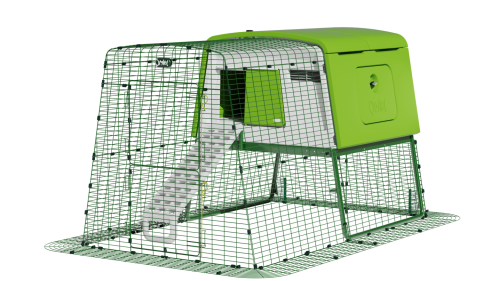Red mites are small, bloodsucking insects that can set up home in your chook’s coop. Generally, these parasites will remain dormant in the daytime, instead coming out at night to feed on your birds’ blood.
Whilst all coops can harbour red mites, wooden coops are more likely to do so, as they are generally more difficult to thoroughly clean than plastic alternatives. Pressure washing plastic coops such as the Eglu can be both a simple and an effective way to help rid your chickens of red mites. Doing the same for wooden coops is difficult and time-consuming, as the wooden coop must be thoroughly scrubbed and left to dry.
There are two principle ways to tell if your birds are suffering from a red mite infestation. First is through checking for symptoms in your birds.
Symptoms include:
- Fewer eggs being laid
- Pale combs
- Pale wattles
- Red or grey mites on the bird, particularly around the vent
- Anaemia
The second method of diagnosing red mite infestations is by checking the coop itself. These mites are visible to the naked eye, and will try to hide in nooks and crannies in your birds’ enclosure. One good method of identification is through using a white paper towel. Running this firmly over some of the crevices of your birds’ coop should help you identify their presence – tell-tale red streaks will be left on the paper.
Treating red mites can take time. It’s often very difficult to get rid of red mite infestations, but it’s by no means impossible, and by taking action you can drastically reduce red mite numbers, even if you don’t eradicate them on the first try.
- Remove your chickens from the coop, and place them in a secure environment with adequate food, shelter and water.
- Remove all bedding and waste materials from the coop. Instead of putting this on your compost heap, it’s best to dispose of it, otherwise the eggs will eventually be spread round the garden. You may also want to empty and clean the feeder and the waterer.
- If you have a wooden coop, you will need to dispose of any felt or similar materials, and get them refitted later.
- Use mite disinfectant throughout the coop and run. Be sure to get it into all the nooks and crannies. Apply as directed.
- Hose down the coop and the run. If you have a high-pressure hose, this would be beneficial to use. Again, try to get into all the nooks and crannies where the parasites are likely to be.
- Let the coop dry for fifteen minutes
- Return to the coop and analyse it thoroughly. Can you spot any mites crawling out of their hiding places? If so, pressure wash the coop again. Repeat until you can see very few mites coming out
- Let the house dry off properly
- Reassemble the coop and put in fresh bedding.
- Use red mite powder throughout the whole coop, paying special attention to your bird’s perches, where mites are frequently found.
- Apply red mite powder to your chickens (adhere to the product-specific directions!)
- Re-apply as directed. If not mentioned on the container, you may want to re-apply the powder after a few days.





Comments
There are no comments just yet